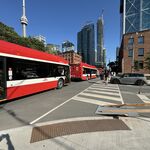MrsNesbitt
Active Member
Although Metrolinx, we can all admit, has failed in its initial goal of being a non-partisan agency taking the politics out of transit, it's true that it maintains a certain degree of decision-making ability and/or independence. That I believe is what Hudak would do to it: remove whatever "teeth" Metrolinx has, and turn it into a brand or a shell under which different services like GO and the TTC subway could be joined.
Of course that's not to say that Hudak couldn't outright dissolve Metrolinx either. He's certainly flirted with the idea before, and I consider him reckless enough to do it. To a PC supporter, an agency like Metrolinx is really at odds with the gospel of small government.
To return to the original point, it's true that people have no idea what a proper regional rail service could do. I've often noted with transit that people prefer frequency over capacity, given the choice, and that's fundamental flaw in our systems as they stand: GO runs 10-or-12-car trains pulled by enormous diesel locomotives at low frequencies, on most lines not even all day, and they run empty much of the day because of the monolithic and inflexible nature of that model. Riders living at Dundas and Bloor will board the subway at Dundas West to commute downtown rather than hop on the GO from Bloor station, even though the GO will get them there faster, because they don't want to pay a higher fare for a service that requires them to conform to a rigid schedule of trains separated by huge gaps in service. Were GO running 4-to-6-car EMUs at 10-15 minute intervals, ridership would skyrocket because trains would be fast AND frequent. As it stands now people are driven to the subway by GO's choice of capacity over frequency - in short, a self-fulfilling destructive prophecy. Not to mention even the fare structure and lack of local bus connections. This needs to be addressed, or else we'll keep wasting untold billions on subways into the depths of suburbia (like the mind-numbingly-stupid Vaughan Centre extension) when GO could just as easily, or even more easily, accommodate the same trips. Bringing the whole TTC directly under Metrolinx control would work wonders for these problems.
Of course that's not to say that Hudak couldn't outright dissolve Metrolinx either. He's certainly flirted with the idea before, and I consider him reckless enough to do it. To a PC supporter, an agency like Metrolinx is really at odds with the gospel of small government.
To return to the original point, it's true that people have no idea what a proper regional rail service could do. I've often noted with transit that people prefer frequency over capacity, given the choice, and that's fundamental flaw in our systems as they stand: GO runs 10-or-12-car trains pulled by enormous diesel locomotives at low frequencies, on most lines not even all day, and they run empty much of the day because of the monolithic and inflexible nature of that model. Riders living at Dundas and Bloor will board the subway at Dundas West to commute downtown rather than hop on the GO from Bloor station, even though the GO will get them there faster, because they don't want to pay a higher fare for a service that requires them to conform to a rigid schedule of trains separated by huge gaps in service. Were GO running 4-to-6-car EMUs at 10-15 minute intervals, ridership would skyrocket because trains would be fast AND frequent. As it stands now people are driven to the subway by GO's choice of capacity over frequency - in short, a self-fulfilling destructive prophecy. Not to mention even the fare structure and lack of local bus connections. This needs to be addressed, or else we'll keep wasting untold billions on subways into the depths of suburbia (like the mind-numbingly-stupid Vaughan Centre extension) when GO could just as easily, or even more easily, accommodate the same trips. Bringing the whole TTC directly under Metrolinx control would work wonders for these problems.




